Kensington’s State Heritage Places
The following buildings or items in Kensington are listed on the South Australian Heritage Register:
| Property Address | Description of Place of Value |
| 39-49 Bishops Place | Dwellings – six row houses |
| 53 Bridge Street | Shop (former Boot Factory & Dwelling) |
| Adjacent 53 & 55 Bridge Street | Bridge, Kensington (Brick Arch) |
| 60 Bridge Street | Rising Sun Inn |
| 36 High Street | Shops (former Rising Sun Hotel) |
| 38-40 High Street, (also known as Unit 1/38 & Unit 2/38 High Street) | Shops (former Shops & Dwellings) |
| 42 High Street | Shop & Dwelling |
| 50 High Street | Dwelling – “Cypress House“ |
| 157 & 161 Kensington Road | Attached Bluestone Dwellings |
| Portrush Road | Benson Memorial Drinking Fountain |
| 286 Portrush Road | St Joseph’s Convent including the 1876 chapel tl main building & additions to it. |
Kensington’s State Heritage Places -Details
Details of each of the State Heritage Places follow:
39-49 Bishops Place
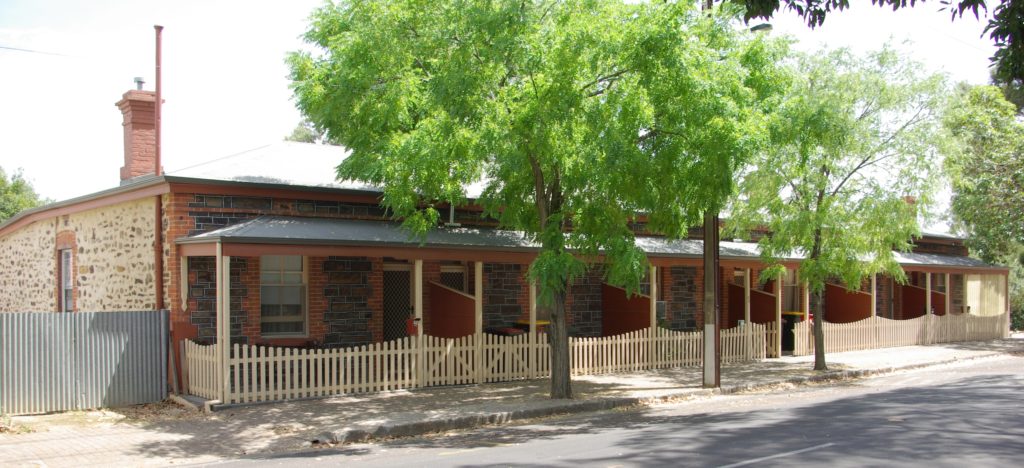
A neat terrace of six row houses built in the 1880’s. The tenants were mostly employees of the Adelaide & Suburban Tramway Company, the first tram company in Australia. The Kensington to Adelaide line was its first line, operating as a horse drawn tram from 1876 until electrification in 1909. The houses were restored by the S.A. Housing Trust in 1976.
53 Bridge Street
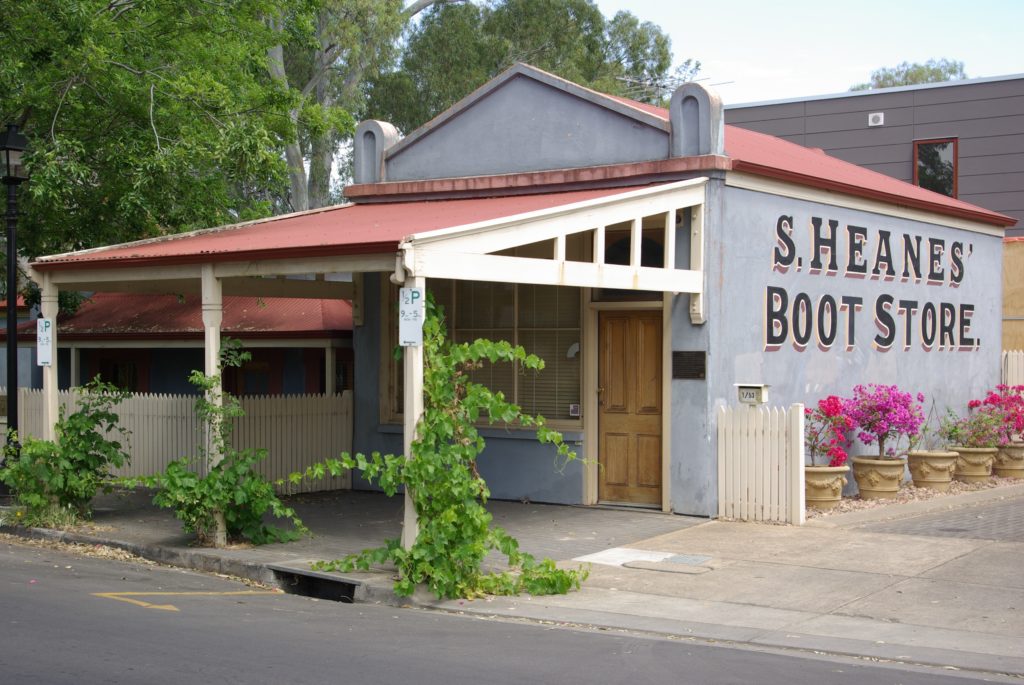
The original shop and dwelling were built for bootmaker, Samuel Heanes, in 1847. The first workshop with wattle-and-daub walls, thatch roof and slate floor was at the rear and was still standing until the 1980’s. Before 1853 he had a brick house of four rooms to which he added a room on the end near the creek. The existing shop was erected in 1878 to the right of the house.
Samuel Heanes was a Councillor for Kensington for twelve years and a member of the Volunteer Rifle Movement.
The Bootshop traded for 133 years until Samuel’s grandson Alfred Heanes retired in 1981.
Bridge adjacent 53 Bridge Street
The Second Creek bridge was built in 1858 for £96 (raised by public subscription), of brick vault construction. Two earlier wooden bridges had been destroyed by flood. It was an important crossing over the creek, formerly known as Hallett’s Rivulet.
Rising Sun Inn – 60 Bridge Street
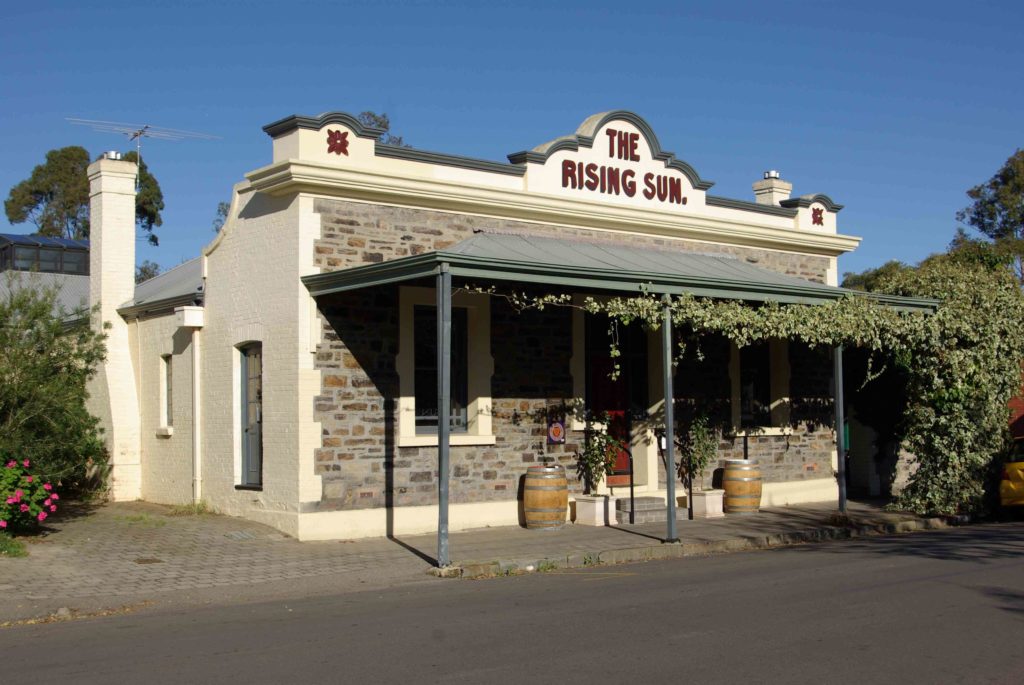
The Inn was built in 1848 as an ale house with a “tap room” run by William Beck, a notable figure in early Kensington, known as “Black Beck”. In 1849 Beck began the first passenger cart service from Kensington to Adelaide.
In 1868, the inn was purchased by brewer and businessman Sir Edwin T Smith who added the bluestone façade and parapet. The Inn closed in 1883 when Smith transferred the licence to the “new” Rising Sun Hotel on the intersection of Bridge & High Streets. It became a private residence until 1951 when R.P. Tilbrook commenced manufacture of the only locally made motor cycles on the premises.
In 1983 the building was restored and commenced trading as an historic inn, 100 years after its original licence was transferred.
Legend has it that there was a murder in the cellar and to this day people report a mystery presence near the cellar.
The original line of the inn and walling can be viewed from the side of the building.
Rising Sun Hotel – 36-42 High Street
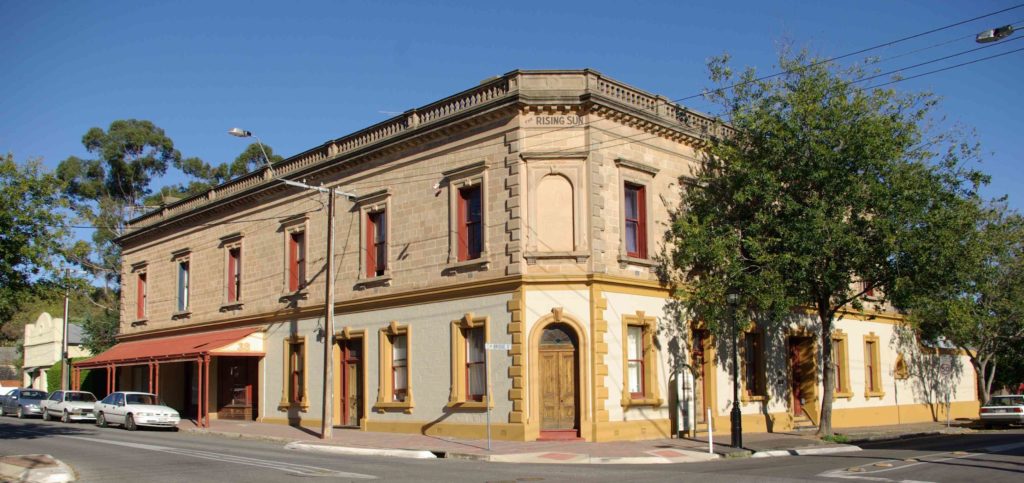
This beautiful Victorian sandstone building was built in 1882 as a showy new hotel by Kent Town Brewery magnate Sir E T Smith. It was designed as a 34 room hotel incorporating 3 shops and is the most prominent building in the village.
In 1893 the publican, Louis Rothenberg, hanged himself at the foot of the stairs when his race horse ‘Dust Storm’ died during the Tatterstalls Cup.
For some reason the hotel never proved to be popular and in the local option poll of 1909 it lost its license and became a boarding house.
Only a portion remains of the original verandah that returned into Bridge Street along the full length of the street frontages.
Cypress House – 50 High Street
The house was a doctor’s residence and surgery for nearly 100 years. The building dates from before 1842 and was first occupied by colonial solicitor Charles Fenn. In 1851, Dr Thomas Taylor purchased the cottage and adjoining block and set up a surgery. The arched portico on the western side was the entrance to the waiting room of the surgery and is indicative of very early colonial architecture. Dr Taylor served as Mayor in the 1860s and carried out major alterations to the property.
In 1867 Dr John Benson bought the practice and endeared himself to the local community. He ministered to all whether they could afford his services or not. His death from pneumonia in 1877 devastated the community and a memorial fountain was erected (see Benson Memorial Drinking Fountain below).
Dr Sprod took over the practice and was appointed as the first heath officer in the municipality. The Victorian façade with its gable entrance was probably added during his ownership because Dr Benson is not considered to have had the money for this high quality extension. However, Peter Skellon has suggested that: “the early Victorian characteristics suggest an earlier date:- the beautiful proportions, the double windows to each room, the unusual internal doorway skylights and the full thickness internal walls”. The original photo of the house has Dr Sprod on the verandah and one of his daughters standing in front of the fence with her tricycle.
Doctor Thomas Borthwick succeeded Dr Sprod and lived there from 1886 until 1924. He was prominent in the fields of public health and bacteriology as there were increasing outbreaks of typhoid and cholera due to the contamination of water supplies from effluent. He is recognised for his services to the community with the local park named after him. Drs E & F Borthwick continued the medical practice until late 1947.
When Peter Skellon purchased the property in 1983 it was being used as the yards and office for a drilling contractor. The house was in a very sad state of repair, without any formal heritage recognition or protection, and in danger of being demolished. Peter lovingly restored the house to its former glory over a period of 20 years. Peter was a very active member of the KRA, serving as both President and Vice-President, and was a strong advocate for the protection of Kensington’s heritage during his twenty years as a Kensington resident. The Association acknowledges Peter’s overall contribution to the protection of Kensington’s heritage through his restoration of Cypress House and his untiring work with the Association over 20 years.
Some of this information has been extracted from a summary Peter Skellon compiled about the history of the house and the things he discovered during his renovations. Click here to read the full article.
Cypress House was listed as a National Trust Recorded Item on 7 February 1985.
It was added to the State Heritage Register on 30 August 1990.
Benson Memorial Drinking Fountain – intersection of High Street & Portrush Road
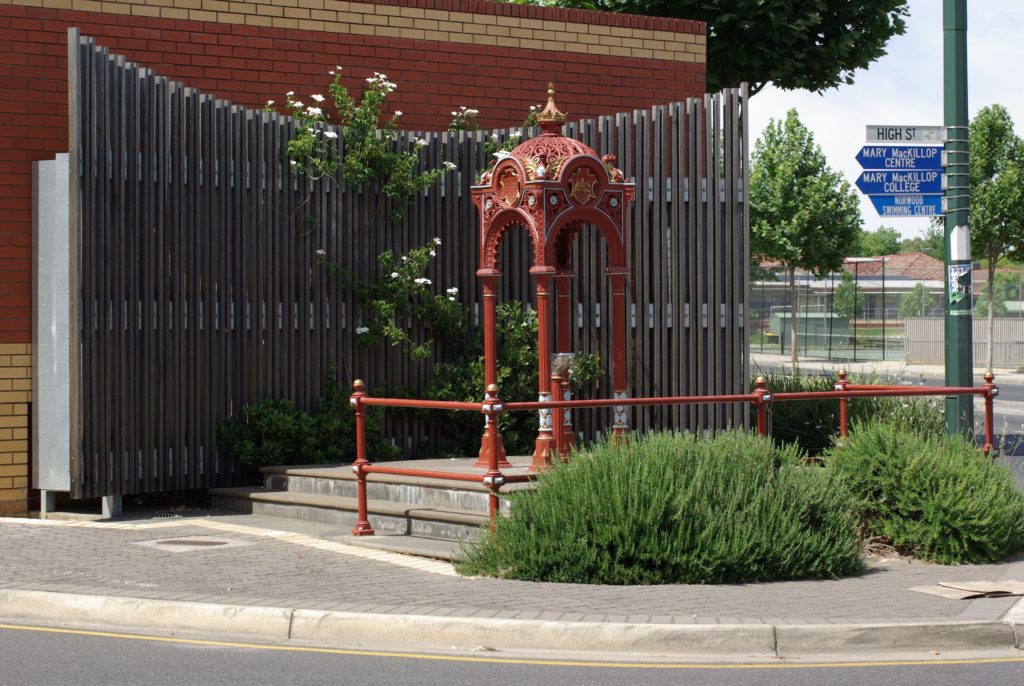
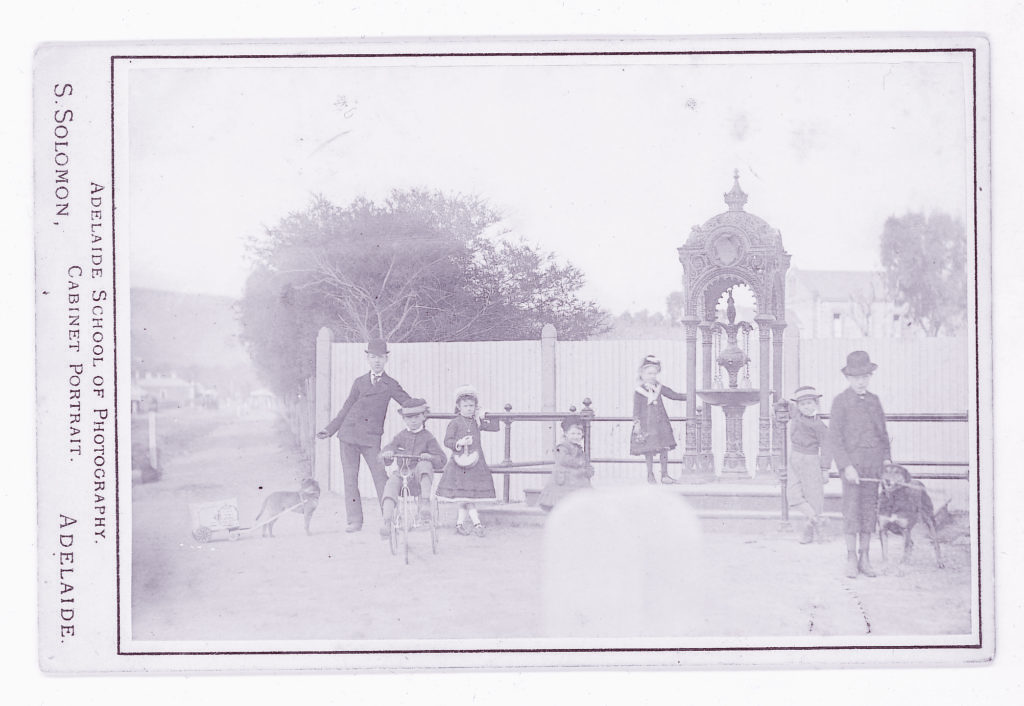
Dr John Benson served the Kensington and Norwood community for ten years and in that time gained the loyalty and admiration of a large number of people. Tragically he died of pneumonia on the 8 July, 1877 aged 39 years. On the day of his funeral shops were closed and flags were flown at half mast. The mile-long funeral procession of many carriages and hundreds of mourners from all sections of the community followed the hearse from his High Street home to St Bartholomew’s Church, Norwood and then to West Terrace Cemetery
The fountain was erected by public subscription in 1879 on land given by the Sisters of St Joseph who respected the much loved Dr Benson. The memorial fountain was unveiled by Lady Elizabeth Smith wife of Sir Edwin T Smith then Mayor of Adelaide (formerly Mayor of Kensington & Norwood).
Note the early Australian coat-of-arms long before the advent of Federation.
The fountain was moved slightly from its original location and restored to its original glory as part of the upgrading and widening of Portrush Road in 2004. The restoration would not have happened without KRA’s prolonged and persistent lobbying of Council and Transport SA. KRA contributed to the cost of the painting using an original colour scheme.
Fountains of identical design are to be found at Hay, New South Wales and near the Clifton suspension bridge, Bristol, England.
157 & 161 Kensington Road
These well designed and detailed bluestone terrace houses were built for Sir E.T. Smith in 1892. For some strange reason (believed to be an omission) the middle house, No 159, was not State Heritage listed but has recently been listed as a Local Heritage Item by Council.
The nearby terrace houses at 151 – 155 were also built by Smith in 1882.
St Joseph’s Convent & Chapel – 286 Portrush Road
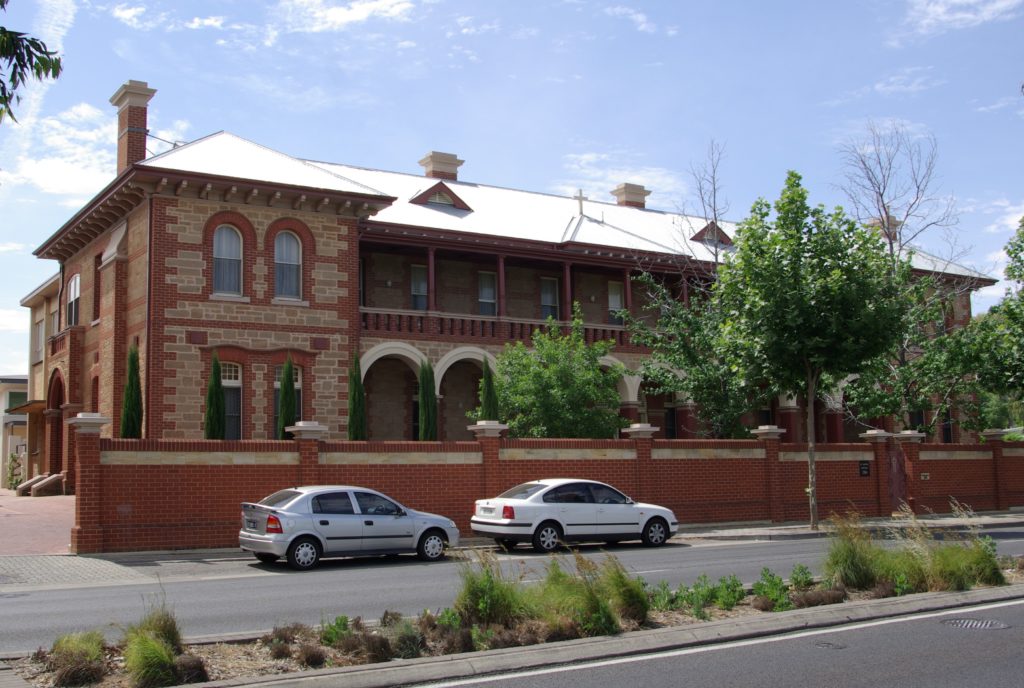
The provincial home of the Order of the Sisters of St Joseph, the Institute was founded in South Australia by Father Julian Tenison Woods and Mother Mary MacKillop in 1866. In 1872 after Mary MacKillop’s excommunication order was lifted the Sisters of St Joseph moved from Norwood to an eight roomed house and a cottage on this site on a triangular piece of land which had belonged to Elizabeth Main.
The foundation stone for the Kensington Chapel was laid on the 8 September 1875. The chapel was on the ground level with sleeping quarters for the Josephites above and below. By 1905 it was apparent that the convent would have to expand and so the main double storey building facing Portrush Road was officially opened by the Catholic Archbishop, John O’Reilly on 24 June, 1906.
Mother Mary MacKillop lived at Kensington from 1872 until 1883. She died in Sydney on 8 August, 1909. The cry for her sainthood began in 1926.
Sources:
Kensington Village Historical Walk brochure, compiled by Denise Schumann 2007.
City of Kensington & Norwood Historic Tour Guide, compiled by Daniel Manning 1986.
Old Kensington – A Local History Guide, R.M. Gibbs.
State Heritage Places Owners’ Guide, Department for Environment & Heritage.
Peter Skellon.
